Nick Coppola, Puppetworks Founder, Remembers Brooklyn During WWII, His $21/Month UES Cold Water Flat & The NYC Automat
The lifelong puppeteer, 89, also talks about being drafted and performing puppet routines for injured soldiers in Army hospitals.
Hi! How’s your week going? I’ve been busy getting ready for the 5th Ave Music and Art Stroll tomorrow. Can you stop by? I’m looking forward to seeing some of you there!
I’m so excited about today’s interview with Nicolas Coppola, lifelong puppeteer and the creative genius behind Puppetworks. “I was 19 when I started as a professional puppeteer. It's just been my life,” Nick told me during a recent phone interview. Throughout his 20s and 30s, Nick worked for puppet theaters in NYC, and he also toured across the country, from Buffalo down to Florida and into Texas and New Mexico.
In 1980, Nick founded his own company, The Puppetworks, Inc., which later opened on the corner of Sixth Avenue and Fourth Street in 1991. It’s been a neighborhood institution ever since. “We’re getting grandparents who say, ‘I used to come here!’” said Nick. “It’s gone by in a blink.”
Nick was Puppetworks’ Artistic Director, producing shows in Park Slope and around NYC — including at Macy’s for 38 years — for decades. “Nick understands what children enjoy in the theater. Parents and Teachers alike are amazed at how Nick's scripts hold a child's attention,” said Terry Alan Smith, Puppetworks General Manager, who has worked with Nick since 1969. While Nick is enjoying retirement on Long Island, living in the home his parents built in 1950, he still oversees the productions and will take the Long Island Rail Road to Park Slope to visit the theater.
In his interview, Nick talks about the Suzari Marionettes puppet show he saw in elementary school that inspired his life’s work, a personal memory from December 7th, 1941, his dream for Puppetworks, and more. He also shares his go-to Park Slope diner and the hardware store that Puppetworks has used for years.
Kelley MacDonald: Hi Nick! I was excited to see Puppetworks’ new show opened a couple weeks ago.
Nick Coppola: Yes, we opened The Prince and the Magic Flute on Saturday the 31st, which is our 31st season in that location.
Wow, congratulations! That’s a big number. How do you feel about it?
Look, I'm 89. I don't think about dates anymore [laughs]. I'm just glad to see the morning each day [laughs].
When did your family move to Brooklyn, and what was it like growing up in the borough in the ‘30s and ‘40s?
My mother and father were both born in Sicily, but my mother was raised here. My father came here in his 20s. Their first apartment was on Carroll Street, on the other side of Third Avenue near the Gowanus Canal. Later, they moved to Bath Beach, Cropsey Avenue, Brooklyn, where I was born in 1935.

We had a big apartment on Bay 22nd Street and Cropsey Avenue. It used to be a hotel, I think, because Bath Beach had been sort of like a resort [along the waterfront]. We overlooked the Belt Parkway. When I was a kid, there were no homes between the Belt Parkway and my street, Cropsey Avenue. So, as kids, we had all this open area to play; it was like living in the country. It had been beach land, but then they built the Belt Parkway. After World War II, Fred Trump built a bunch of homes in that area with these brick homes still standing today.
What do you remember about life in Brooklyn during World War II?
I lived in a neighborhood where we were predominantly Italian and Jewish of either Polish or German descent. Everybody had people over there that they were worrying about, and although we played and lived our normal lives, there was always somebody having bad news or somebody coming home. We used to, every now and then, wrap packages and send them to our relatives in Sicily, some of them who were living in caves, just hiding out.
At one point, I think I was about seven, I was looking at a map. I asked my older sister, “Is Canada in the war?” She said, “Yes, everybody's in the war.” I started crying. I said, “Well, the Germans are in Canada. They can come down and get us. Look, it's right over New York.” She said, “No, they’re not here. They’re in Europe.”

I have a wonderful picture of my mother and father and my aunt and uncle. They were going to a wedding, and they were all dressed up. The ladies had lovely gowns, and the men were in tuxedos. They had their picture taken, which was common, you went to a photographer on those occasions and then went to the wedding. I remember they all came home early, and we didn't know why. It was December 7th. Can you imagine those poor people who had a wedding that day? I didn't realize it that day, but when I put it all together, oh, dear.
The newsreels would show you scenes that you couldn't believe. I'm sure it shaped some of my thinking, but I don't know exactly how. We were relatively untouched by it, you know, as kids.
Wow, thank you for sharing those memories with me, Nick.
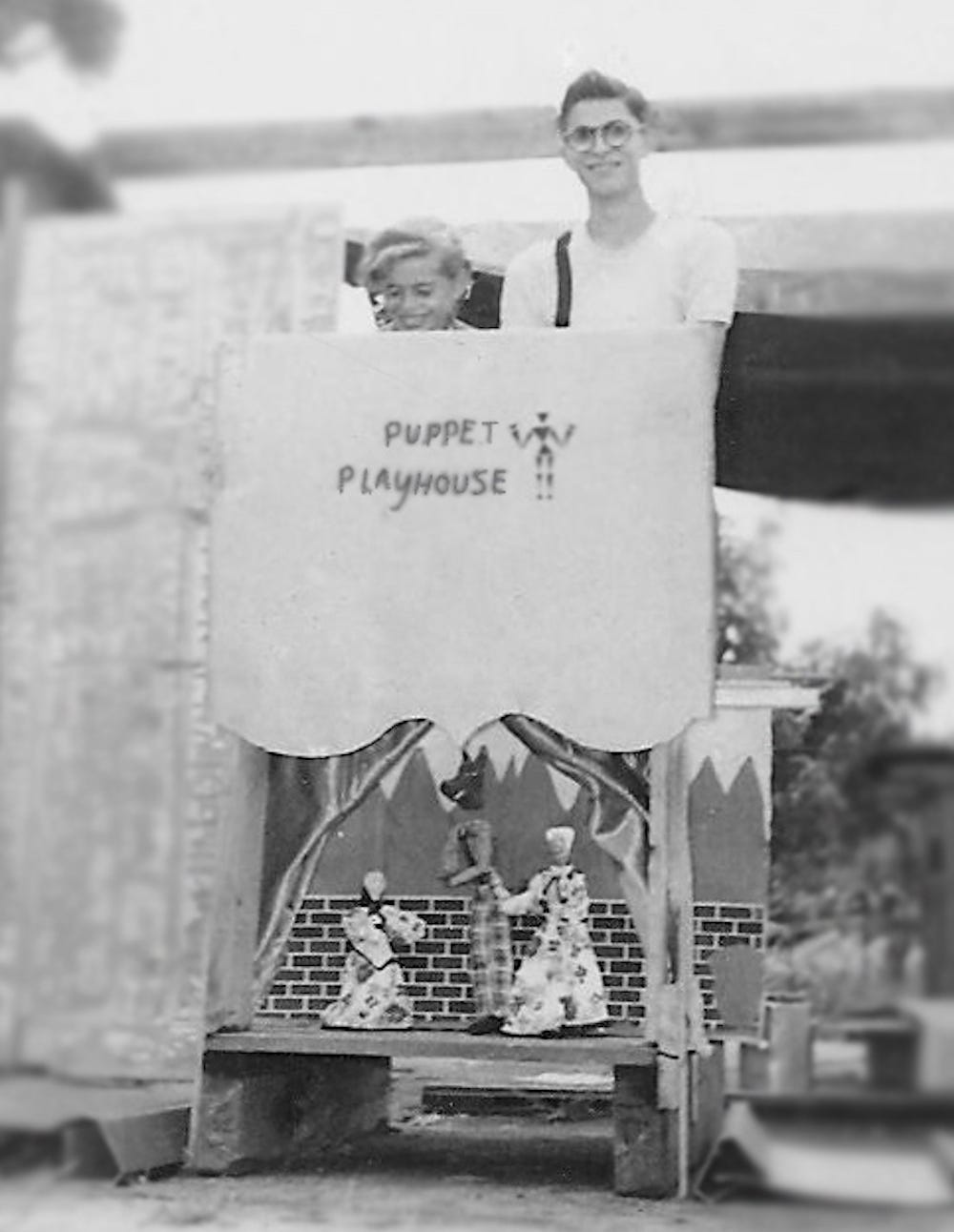
Where did you go to school?
I went to PS 200, and then [for] junior high school PS 128. At one point, I took a test to get into what's now called The High School of Art and Design, but when I was going there, they had the simple name of The School of Industrial Art. I majored in window display, which was the only thing that was close enough to puppetry. It was a wonderful school; I had four great years there.
When I was a kid in PS 200, we used to have Suzari Marionettes come every year. I'd seen marionette shows, but I didn't know anything about how they came about until I found a book in the library. Then, I started making my own puppets. I was the class artist.
Did your parents’ careers influence your creativity and interest in art as a child?
Well, certainly my mother's skills rubbed off on me — not on any of my sisters [laughs]. I'm very good with fabric. My mother was an embroiderer. It's hard to explain what she did. You know, ladies’ sequin gowns? She did that. She was phenomenal. You have to see it to believe it — they work upside down. They put a needle in the fabric, and pull up sequins one by one. She did that since she was a teenage girl.
My father had many jobs, and finally ended up being a house painter. I'm not good with paint [laughs]. My dad — I was his only son, and he was a great athlete, and I was anything but. We went to the ballgame, and I was so bored, I could scream. The following week, I'd been raving about going to the museum with the school, and he started taking me to museums every week. This was a man, you know, he'd been working on the ships on his way over to America, but he had an innate intelligence to give me what I needed, which was great. My sisters and I have always marveled at what great parents we had, and how lucky we were.
Did you go to college?
I had a terrible time in the first year of college, so I fled. I went to St. John's in Brooklyn. Not going to an art school was a big mistake. I just didn't have proper guidance in that. So, I went out and got my first job.
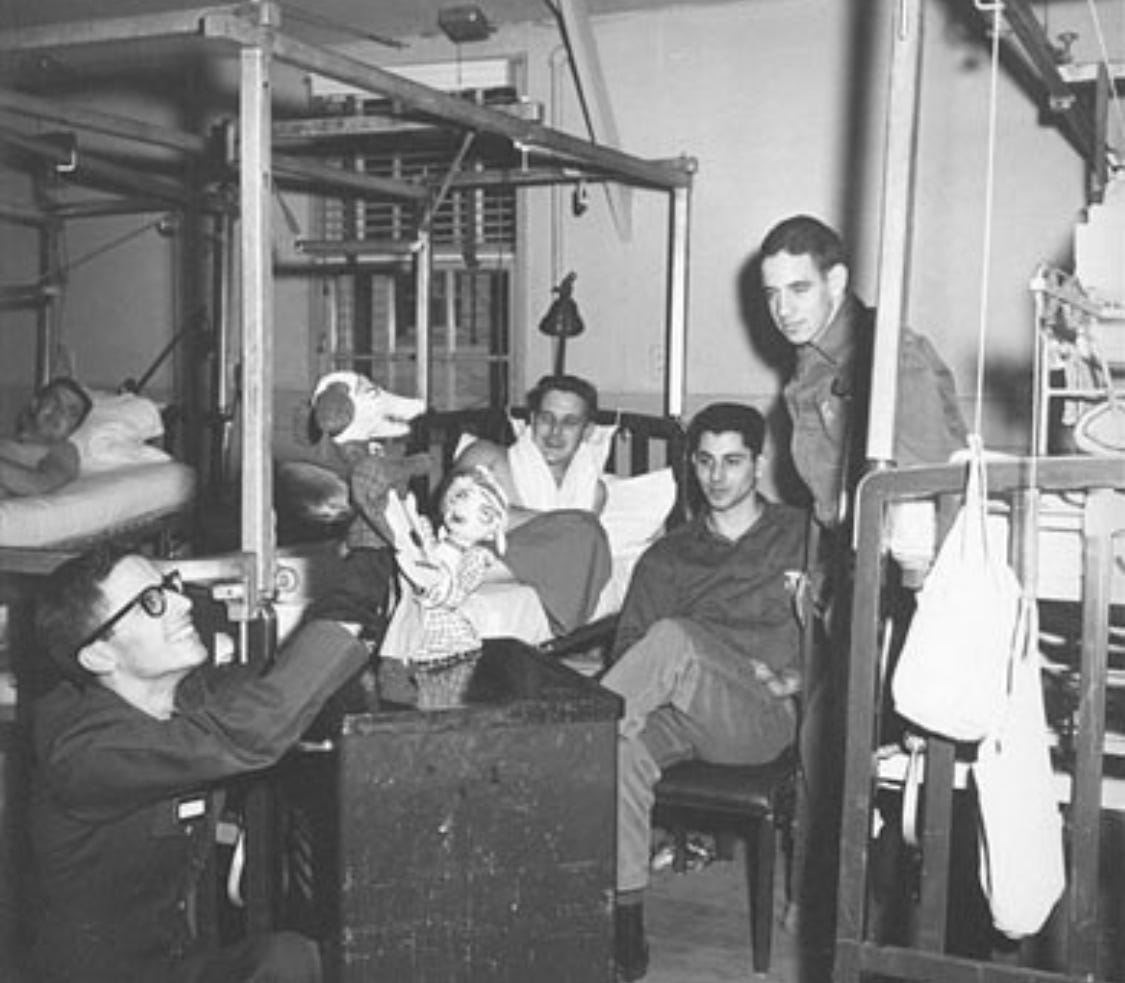
Shortly after you started working as a professional puppeteer, you were drafted. What was it like being in the military in the late ‘50s?
I was scared out of my mind. It was 1958, and I'd already been working as a professional puppeteer for two and a half years. I said, “What's going to happen to me?” Well, I got there, and during basic training, I broke my ankle. So, that sort of stopped basic training for a while.
My family brought my suitcases of hand puppets down, and I started doing shows in the hospital, not only for the soldiers but the families too. I had a real job too. I was assigned to duty as a supply clerk, which was a good job. But I had the opportunity to do my shows too, and I had a regular schedule. We also had a radio station in the hospital, and I ended up doing scripts for a weekly drama session for the hospital play. It was only for the patients, it didn't go out into the world, but it was a wonderful experience.
There was no action those two years of the war by some miracle. Even though I went in kicking and screaming, I came to love it and appreciated all the opportunities I had to develop what skills I had. It was the time I should have been at an art school, so it took that place. It was really invaluable. I made friends that I had for life.
What did you do after the Army?
I went back to work as a puppeteer with the Suzari company. Then, in ‘62, the partners of that company decided to split. Ruth Waxman named her company after me. Why? Why not [laughs]? So, it was the Nicolo Marionettes, and we did a lot of work there until she passed away in 1978.
The family didn't want to continue with the company, so I had to start a new one on my own, Puppetworks. We ended up calling it Puppetworks because some of our friends and puppeteers opened a theater called the New York Stage Works on 18th Street in Manhattan. We decided to do weekend shows, so I said, “We'll be the Puppetworks.”

In your 20s and 30s, was it challenging to financially support yourself while working in puppetry?
Yes and no. I had a cold water flat on York Avenue and 74th Street that cost $21 a month, but there were three of us paying the rent, so divided by three. But we weren't making a lot of money. It was a large room with a full kitchen, a shower, and a little half room that was like a closet. The bathroom was in the hall, but the previous tenant had broken through [the wall], so you didn't have to go out into the hall.
Then, I moved from there to a $50 apartment, and my salary was $50/$60. That's when I felt the pinch. But you still could go eat out; you still could go to the movies or go to the theater. Alright, so we ate most of our meals at the Automat or at the New York Times which had a cafeteria where you could sneak in, even if you didn't work there. It was a great cafeteria. You could stay there as long as you wanted. They got wise, and you had to have a card to get in. But the Automat was good food, and you could stay there as long as you wanted to. So, after we got out at work, around five, we went and hung out in the Automat until showtime. After, we went to see a show or a movie.
Did you ever have jobs outside of your work as a puppeteer?
My only other jobs were in the movie business. When I fled St. John's, that day, I went out and picked up The Times. There was an ad for work in a movie studio, and I had stars in my eyes. I was 18. I got that job. It was with Columbia Pictures. I took time off to go do the hand puppet show for Suzari, and then, they didn't have a regular job for me. So, I went back to the movie business, and I ended up being a still clerk with the 8 x 10 stills at United Artists. I was the clerk who kept them in the files and gave them out to people who wanted them. I was very aware of captions. On Facebook, with my friends, if they don't caption the picture, I say, “What? We don't know who it is! What's the point of it?” I’m very strict about captions [laughs]. That was a fun job. I would have stayed there, except the puppets came calling.

Puppetworks was originally based in Manhattan. How did it make its way over to Brooklyn?
This was like 1980, and I moved to Park Place in Park Slope. We had closed the Nicola company around this time. I had stuff in storage, but I didn't have a workshop, so I found a storefront on Third Avenue and Carroll Street. Remember Carroll Street is where my mother and father had their first apartment [laughs]!
We had just enough room to set up one stage, and I was able to send two tours out. We were there maybe two years. Also at the time, we were appearing at Old First [Reformed] Church in Park Slope. We moved in there for weekend shows, and they had a nice big closet for us to leave everything in. It was really ideal, but those steps were a killer.
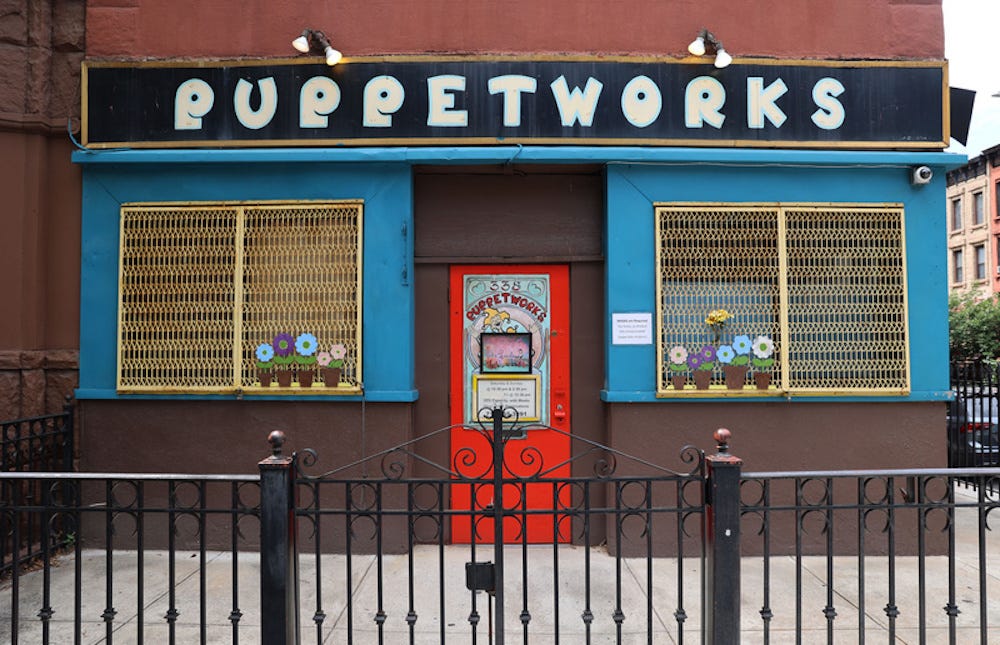
When did you move Puppetworks to Sixth Ave?
While we were on Third Avenue, a friend saw the space at Sixth Avenue and Fourth Street was being used for poetry readings. We checked up on it and found that it had been a Mexican restaurant called El Sombrero Rojo that had gone out of business a while ago. Local people have told me that, way back when, it had been an Irish bar. We had the evidence of that because we had the bar back and all the elements [laughs]. We've been there since.

How do you decide which plays to perform at Puppetworks?
We have a repertory of about 10, 12, 15 shows. Usually, we put a show away for five years and wait for the kindergarteners who saw it to grow up. Terry, who's the General Manager, has all the records and figures out which one to do.
What’s your dream for Puppetworks?
Well, I have to think about how it's going to continue beyond me. I have meetings coming up this next month about that subject. We have people who make puppets and a repertoire, and I have a few dedicated people right now who I think will be happy to continue with it. I hope it can continue.

“The Prince and the Magic Flute” is playing at Puppetworks on Saturdays and Sundays at 12:30PM & 2:30PM, now through November 17th — Get your tickets!
Diner: Nowadays, if I have friends coming in to see a show, I take them to Grand Canyon Diner. It's been there as long as I remember.
Lunch: For a quick lunch, we would typically go to 7th Ave Donuts. I'm sure they haven't ever redecorated [laughs]. They have a certain charm about them. I would get some kind of omelet.
Hardware store: Our hardware store is Leopoldies on Fifth Avenue. We've had an account with them forever. We get staples, screws, glue, and wire; things we need for the staging.
Biography: I love biographies. I recently was reading the biography of Mary Rogers [“Shy: The Alarmingly Outspoken Memoirs of Mary Rodgers”], who was Richard Rogers's daughter. She wrote the music to “Once Upon a Mattress.” She had a very interesting life.
Thank you so much, Nick! We adore Puppetworks!
(Top photo layout by Kelley MacDonald. Automat photo from The National Archives via History Associates Incorporated (HAI). Puppetworks theater photo by George Frey. Leopoldi Hardware photo via Yelp. 7th Ave Donuts photo by Joe Urban. All other photos are courtesy of Nicola Coppola or Puppetworks.)
This week’s puzzle is a photo of a butterfly among the flowers of the Overlook at Brooklyn Botanic Garden, by photographer Michael Stewart.
The puzzle is 60 pieces, but you can change it by clicking on the box of nine dots on the left of the bar, selecting the number of puzzle pieces you want, and clicking OK. Also, you can view the original image by clicking the photo icon on the top bar, and you can make your workspace full screen by clicking at the top right.
Do THE PUZZLE!
New pickleball facility opening later this month in Gowanus: PKLYN will offer five courts and several lounge areas with food and beverages available to purchase. The facility is located at 80 Fourth Street, between Hoyt and Bond Streets and will be open Sunday through Thursday, 6AM-10PM and Friday through Saturday, 6AM-12AM.
A tense town hall on Arrow Linen’s proposal to build a pair of 13-story apartment buildings in Windsor Terrace: Neighbors cheered and booed at the developers. Here’s another recap of the event.
Brooklyn Public Library unveils second phase of its $150 million dollar upgrade to the Central Library branch: The second round of upgrades includes an updated Adult Learning Center, a new Teen Center, restored collection areas, renovated Children Center, upgraded data system, and more.
09/20 & 09/21 Grand Re-opening — Face Painting, Balloon Animals, Games, Prizes & More, 2PM-6PM📍Mathnasium of Park Slope
09/20 Latino Heritage Month Family Movie Night: Coco, 3:30PM 📍Park Slope Library
09/20 Outdoor Storytime with Suzi Shelton, 4PM 📍JJ Byrne Playground
09/20 Rebecca Spiegel presents Without Her with Robert Anthony Siegel, 7PM-8PM 📍Community Bookstore
09/20 Beth Stelling, 10PM 📍The Bell House
09/21 University Open Air: Reading the Flight of Birds, 10AM-11:15AM 📍Prospect Park Boathouse
09/21 Yoga on the Stoop, 10AM-11AM 📍Brooklyn Museum
09/21 Creative Time Summit, 10AM 📍BAM
09/21 University Open Air: Awakening Practice: Morning Meditation in Nature, 10:30AM-11:30AM 📍Prospect Park Boathouse
09/21 5th Avenue Music & Art Stroll, 11AM-7PM 📍5th Ave between 1st & 2nd Streets
09/21 A Nose for Roses: A Perfumed Walk in the Cranford Rose Garden, 11AM-2PM 📍Brooklyn Botanic Garden
09/21 Condo Painting, Followed by a Q&A w/Director John McNaughton, moderated by artist/curator Andrew Lampert, 12PM 📍Nitehawk Cinema
09/21 Outdoor Art Making w/Private Picassos, 12PM-4PM 📍5th Ave, Open Streets
09/21 Garden as Catalyst: Create Your Own Artwork, 2PM-4PM 📍Old Stone House
09/21 Dark Urges: A Burlesque Tribute to Baldur's Gate 3, 7PM 📍Littlefield
09/22 Smorgasburg, 11AM 📍Prospect Park Breeze Hill
09/22 Homicide Victims Remembrance Day, 2PM-6PM 📍Lefferts Historic House
09/22 Artist Talk: Makon, Blanchard, Chuse, Greenstein, 4:40PM-5:40PM 📍440 Gallery
09/22 September Quest for Love Book Club, 8:30PM 📍The Ripped Bodice
09/24 Memorializing Ecological Loss (Climate Week), 6PM-8PM 📍Green-Wood Cemetery
09/24 Celebrate ‘Stacey Speaks Up’ with Stacey Abrams, 6:30PM 📍BAM
09/24 Backyard Movie Night: Coyote Ugly, 8PM 📍Bar Louise
09/25 Death Cafe: Climate Week Edition, 6:15PM-7:45PM 📍Green-Wood Cemetery
09/25 Corinne Michaels Brooklyn Event for All Too Well, 7PM-9PM 📍The Ripped Bodice
09/26 Prospect Park Alliance Gala, 6:30PM 📍Prospect Park Carousel
09/26 Turning 5 Talks w/Sarah Birnbaum and Greg Cangiano, 6:30PM 📍Virtual, Brooklyn Conservatory of Music
09/26 Abolishing Surveillance: A Screening of Media Activism against State Repression and for Community, 7PM-8:30PM 📍Interference Archive
09/26 Brooklyn Reads: A Woman Is a School with Céline Semaan, 7PM-9PM 📍Brooklyn Museum
09/26 The Future of Rescue: Badass Bash 2024, 7PM 📍Littlefield
09/26 José Henrique Bortoluci presents What Is Mine with Eric M. B. Becker, 7PM-8PM 📍Community Bookstore
09/26 The South in Black and White, 7PM-8:30PM 📍Old Stone House
09/26 Sopranos: The Musical, 7:30PM 📍Union Hall
Thanks so much for being here!! Coming up: Illustrator and author Sean Qualls tells us about his new book with Questlove and a record store he loves that has “a very good curated section of used records that are very affordably priced.”
Hope you have a great weekend!
Kelley xo







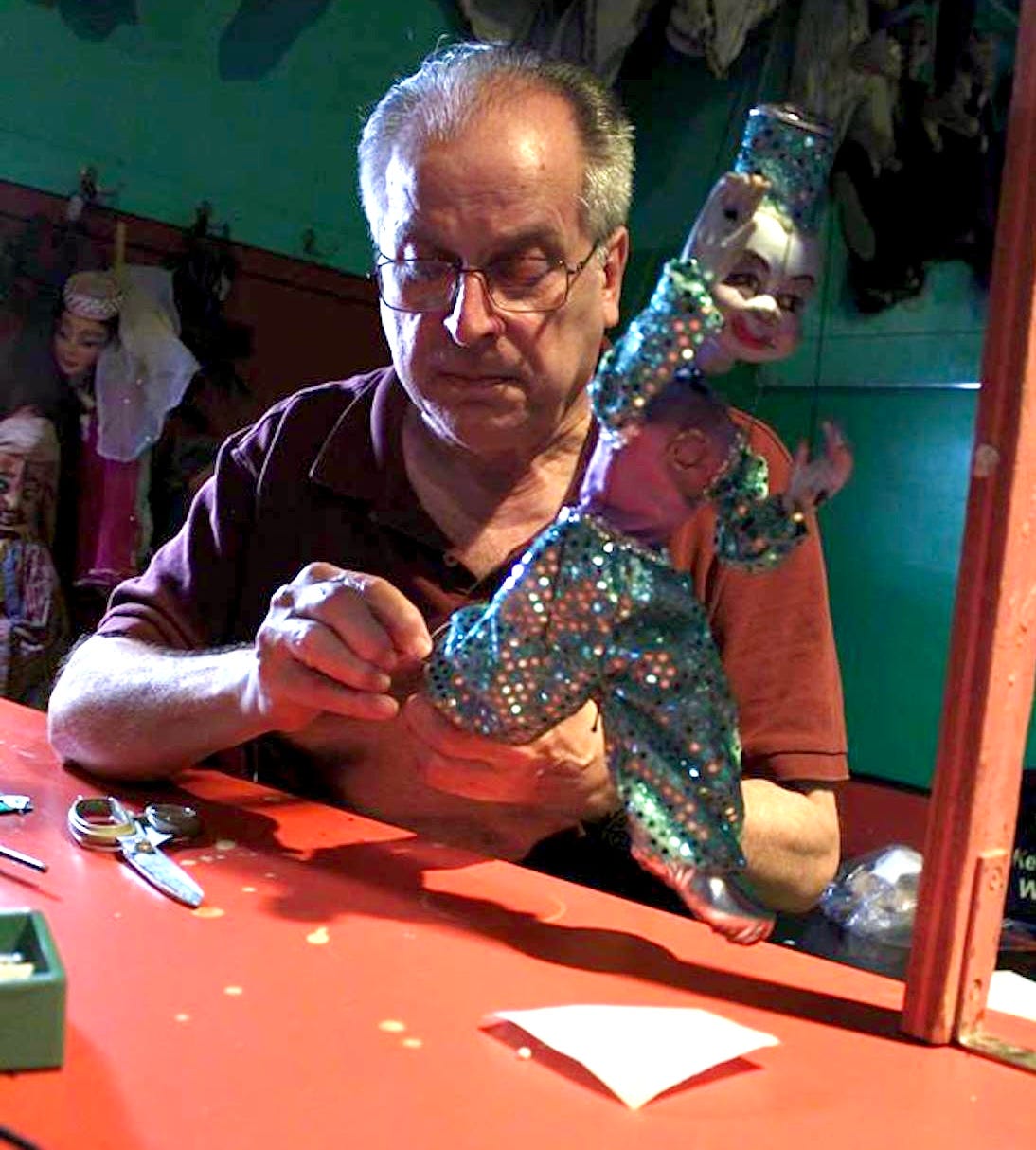




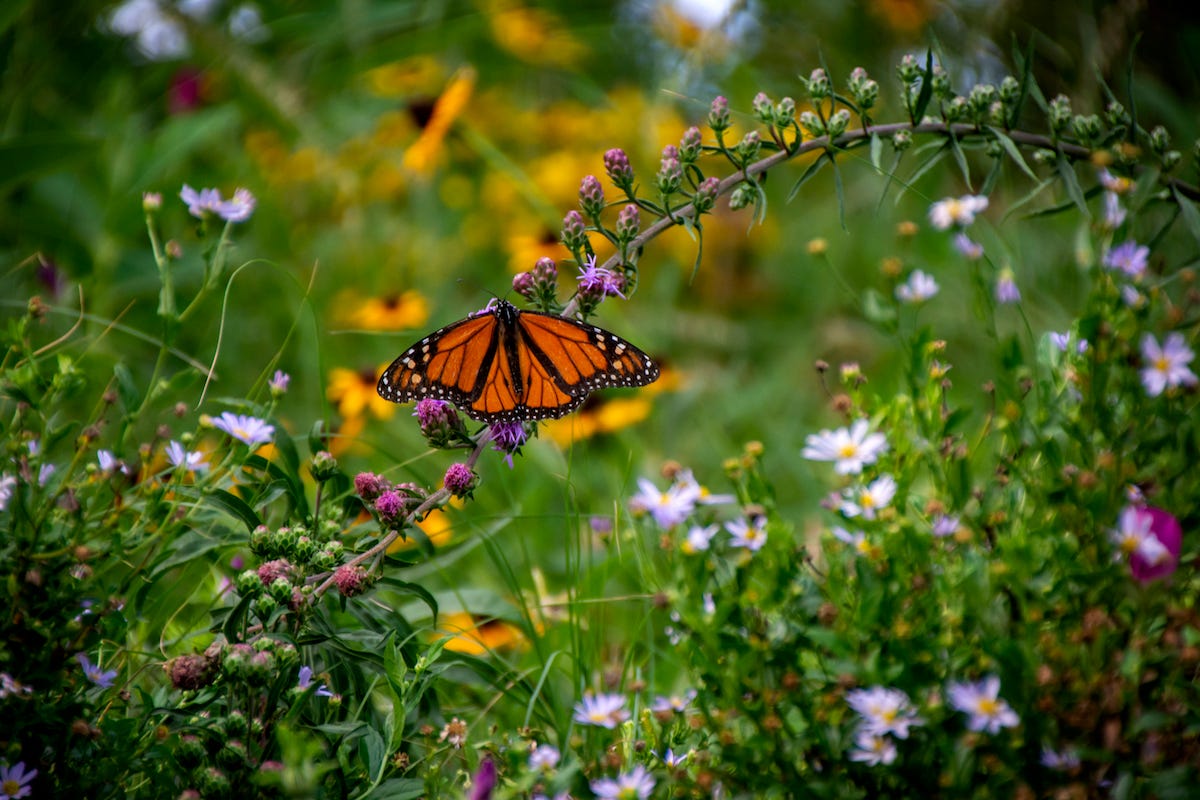


Wow! Great interview about fascinating Nick Coppola! Wonderful to read about someone who followed his passion and found joy and satisfaction. Another example of the perks of living in Park Slope. Well done!!